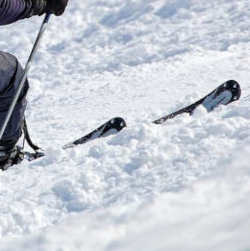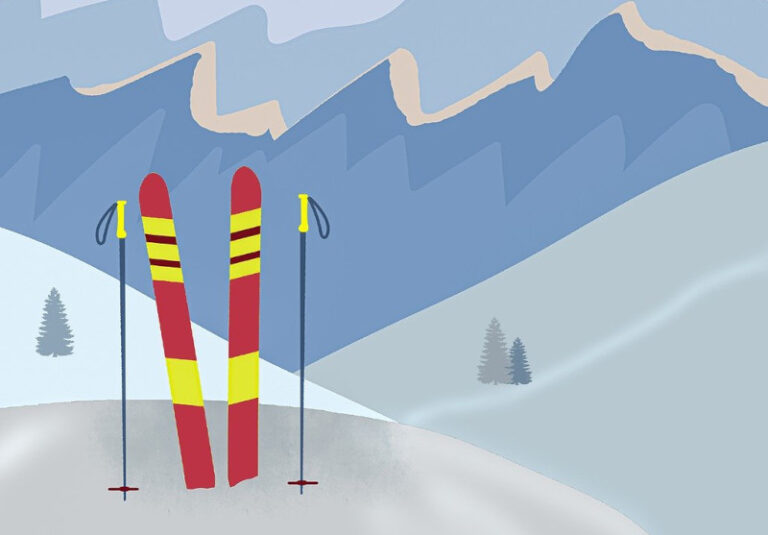How to Master Downhill Skiing Techniques for Challenging Terrain

Skiing on challenging terrain requires skill, confidence, and preparation. From hard crust to powder, each snow condition presents unique obstacles and demands specific techniques. Understanding the characteristics of the terrain and applying the right methods—like using short turns on ice or leaning back slightly in powder—can make all the difference. With practice and attention to your form, you’ll be able to conquer even the toughest slopes. Remember to prepare physically, stay safe, and enjoy the ride!
Downhill skiing can feel like both a test of skill and an adrenaline rush. Whether you’re carving through powder, slush, or ice, each snow condition demands a unique approach. This guide breaks down six common snow types and terrains—hard crust, crud, slush, ice, powder, and moguls—and offers practical tips for skiing on them. By the end, you’ll be ready to tackle any slope confidently.
Hard Crust

What Is Hard Crust?
Hard crust forms when a surface layer of snow thaws and refreezes, creating a thin, icy layer that can feel brittle. Wind exposure can also pack the snow tightly, resulting in a firm, slick surface.
Why Is It Challenging?
Hard crust makes edge grip tricky. The surface may feel slippery, causing skis to lose control. If the crust is thin and breakable, it can create uneven patches that surprise skiers mid-turn. Hard crust is sometimes considered one of the worst types of snow for skiing especially when it is just thick and hard enough to sometimes break through and sometimes not. This creates a very unpredictable surface.
Techniques for Hard Crust
- Stay Balanced: Keep your weight centered to maintain stability. Avoid leaning too far forward or back.
- Sharpen Your Edges: Well-tuned edges grip better on hard snow. Dull edges can slip easily.
- Use Short Turns: Make controlled, short-radius turns to keep movement precise.
- Be Smooth: Abrupt movements can cause skis to lose traction. Glide into each turn with steady pressure.
- Find Another Run: Just kidding, no but seriously find another run… (I hate hard crust)
Crud

What Is Crud?
Crud is snow that’s been chopped up by previous skiers or by weather conditions like wind or warming. It’s uneven, chunky, and unpredictable.
Why Is It Challenging?
Crud can throw your skis off balance, making turns feel jerky. Hidden patches of soft or hard snow can disrupt rhythm.
Techniques for Crud
- Shift Your Weight Forward: Keeping a slight forward stance helps your skis cut through the uneven surface.
- Bend Your Knees: Absorb shocks by flexing your knees and ankles. This keeps you stable over uneven terrain.
- Maintain Speed: A moderate speed helps skis slice through crud instead of getting stuck.
- Use a Wider Stance: This improves balance and control.
Slush

What Is Slush?
Slush is wet, heavy snow that often appears in spring or warmer conditions. (You know, like a Slurpee) It’s soft, sticky, and feels like skiing through thick mud.
Why Is It Challenging?
Slush can slow you down, making it hard to maintain momentum. Skis may stick or sink into the snow, requiring more effort to turn. It can also soak you to the bone if you fall and you are not wearing water proof gear.
Techniques for Slush
- Stay Light on Your Feet: Keep a slightly upright posture to avoid digging your skis too deeply into the snow.
- Quick Turns: Use rapid edge-to-edge movements to stay mobile.
- Choose Narrower Skis: Narrow skis perform better in wet snow, reducing drag.
- Keep Weight Even: Distribute your weight evenly across both skis to avoid sinking.
Ice

What Are Icy Ski Conditions?
Ice forms when snow repeatedly melts and refreezes, leaving behind hard, glassy patches. It’s common on well-used slopes or after rain. And it can be hidden. Often when there is ice it can hidden below a thin layer of snow. This makes it extra challenging since it can present itself with little warning.
Why Is It Challenging?
Ice provides little traction, making it easy to slip. Its hard surface amplifies speed, increasing the risk of losing control.
Techniques for Ice
- Use Sharp Edges: Keep your skis in top condition. Sharp edges bite into ice better.
- Apply Edge Pressure: Consistent edge pressure helps skis hold their grip.
- Stick to Short Turns: Avoid wide arcs that can cause slipping. Short-radius turns provide more control.
- Focus on Your Upper Body: Keep your upper body steady to maintain balance while your legs work through the turns.
Powder

What Is Powder?
Powder is soft, fluffy snow, usually after a fresh snowfall. Skiers love it for its smooth, floaty feel, but it comes with its own challenges. Powder skiing, especially deep powder is considered an expert terrain. Though it is fun and sought after it takes some skill to master.
Why Is It Challenging?
Powder slows your speed and can make turning harder. Skiers may sink if they lose momentum or lean too far forward.
Techniques for Powder
- Lean Back Slightly: Shift your weight just behind center to keep the tips of your skis above the snow.
- Choose Wide Skis: Wider skis help you float better in deep snow.
- Make Gentle Turns: Powder rewards long, sweeping turns rather than sharp, fast movements.
- Keep Moving: Consistent motion prevents sinking or losing balance.
Moguls

What Are Moguls?
Moguls are bumps that form naturally on ski runs due to repeated turning by skiers. They require precise technique to navigate smoothly. They come in various shapes and sizes and often form on steeper slopes where grooming is difficult or undesired. Most times moguls form a uniform pattern on the slope or ski run.
Why Are They Challenging?
Moguls create uneven terrain, demanding constant adjustments. Skiing moguls for extended periods can also tire your legs quickly.
Techniques for Moguls
- Plan Ahead: Look several moguls ahead to anticipate your turns.
- Plant Your Poles: Use your poles for rhythm and stability as you turn around each bump.
- Absorb the Bumps: Flex your knees to absorb the impact as you hit each mogul.
- Keep Upper Body Stable: Let your legs do the work while your upper body stays quiet.
- On Top or In Between: You can choose to ski over top of moguls or in between them. Over top require more skill and strength but can be more fun and exciting.
Additional Tips for Skiing Challenging Terrain
- Evaluate the Slope: Before skiing, scan the terrain for hazards, icy patches, or hidden obstacles.
- Stay Fit: Strong legs and a solid core improve your ability to handle uneven conditions.
- Choose the Right Gear: Use skis designed for the conditions. For example, all-mountain skis are great for mixed terrain.
- Take Lessons: Advanced skiing lessons can refine your techniques for difficult terrain.
- Know Your Limits: Push yourself, but always stay within your skill level to avoid injury.

by: T. Belleau
Health and sports are at the heart of Trisha’s writing passion. An avid cyclist, mountain biker, and e-biker, she brings firsthand experience and genuine excitement to her sports-related articles. Trisha’s love for the outdoors extends… read more






